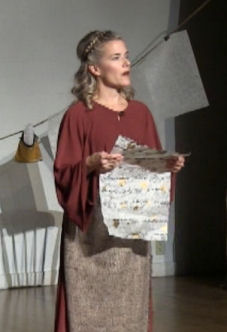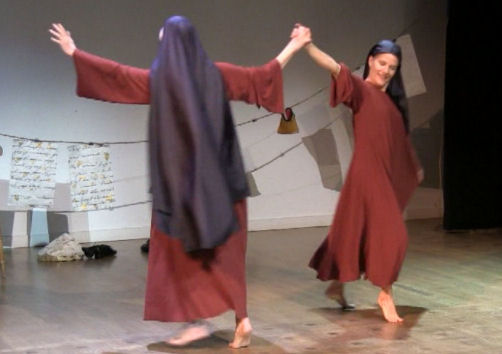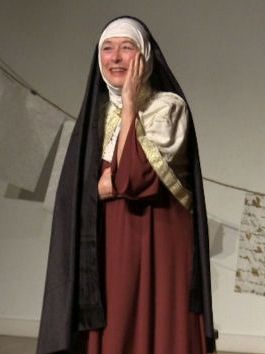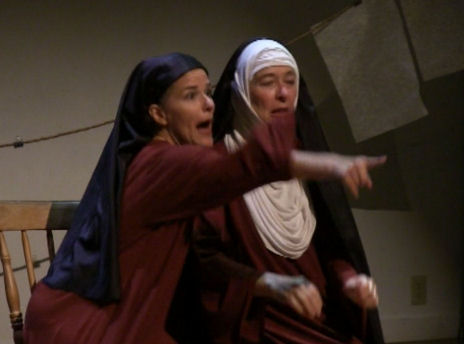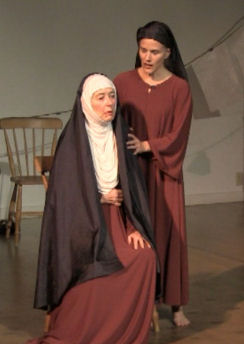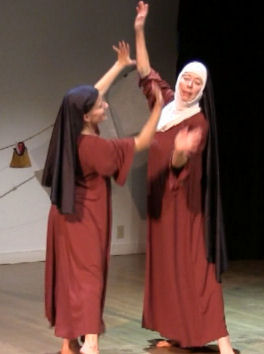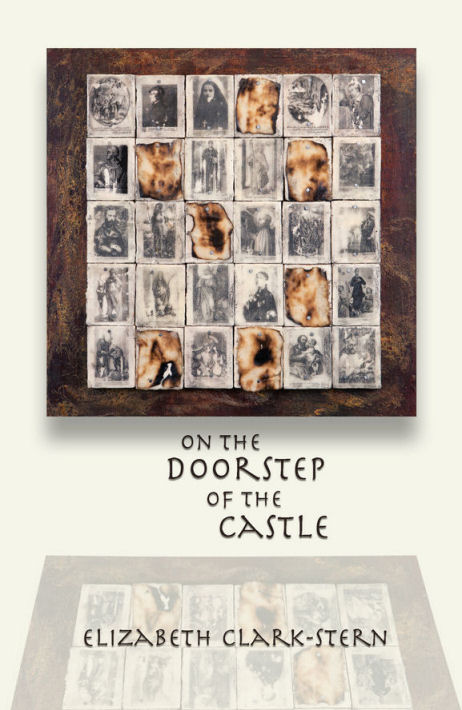|
On the Doorstep of the Castle
A Play with Dance and Music By Elizabeth Clark-Stern
The
setting is 16th century Spain. The
Inquisition has expelled the Jews or forced them to convert.
Teresa of Avila is igniting the imagination of the country
as the nun who receives messages directly from God. Alma de
Leon, a young Jewish converso, appears on Teresa’s
doorstep, petitioning to become a novice in her care. Their
complex relationship explores the feminine archetypes of the
Amazon, and the Medial Woman, in a story that unveils the
foundations of psyche’s movement toward wholeness: Kabbalah,
and Christian rapture, in an oppressive yet luminous time.
This play is a work of creative imagination based on the interaction of a true historical character and a fictional one. Teresa of Avila is admired to this day not only by Catholics and Christians, but by Taoists and Buddhists, psychologists and poets. Carl Jung was fascinated by her master work, The Interior Castle, for its description of the journey of the soul toward intimacy with God. The fictional character, Alma de Leon, is inspired by twentieth century Jewish philosopher, Edith Stein, who chanced to read Teresa's autobiography, and experienced a profound spiritual awakening that led her to become a Carmelite nun. "What if these two were to meet?" the playwright asked herself, crafting the character of Alma as a Jewish woman true to her time and place in history. The teaching of the ancient Jewish mystical tradition, the Kabbalah, was strictly forbidden by the Inquisition, and yet Alma is haunted by it, even as she dons the habit of a nun and struggles to find her identity in the presence of her passionate, spiritually adventurous mentor. LINKS TO: YouTube: Dance Prologue and Opening Scene
Interview: "On
the Doorstep of the Castle—An
Exploration of the
Divine in the Reflections on the creation and performance of the play by Elizabeth Clark-Stern
Reviews
of
By Erel Shalit,
Jungian analyst, author of
Requiem: A Tale of
Exile and Return and
The Hero and His
Shadow.
I often find it difficult to read a play in book form. However,
the gripping drama of Elizabeth Clark-Stern’s ‘On the Doorstep
of the Castle’ comes across in a vivid and powerful way in this
intense book.
The imagined meeting between the historical Teresa of Avila, and
the fictional Alma de Leon carries the intensity of searching
souls. There is beauty coupled with pain, for instance when
Alma, the young converso woman seeks to become a Carmelite nun,
“Such a lovely name. From the hermits of Mount Carmel [God’s
Vineyard], in the holy land. It is said they drank water from
the fountain of Elijah, lived on berries, their only concern,
love. I have a cousin called Elijah. He fled in exile to
Jerusalem when we were but thirteen. His family refused to
submit to conversion.”
The meeting between the two, Teresa the real figure, and Alma,
based on the Jewish philosopher Edith Stein, who converted to
Christianity, yet exterminated in Auschwitz, movingly and deeply
reflect the meeting of the Soul’s Voices.
Nearly every paragraph brings a different turn in their
encounter, whether the Jew in the Christian and the Christian in
the Jew, the feminine faces of the God-image, the teacher in the
disciple, as well as the various aspects of exile and return.
Both figures in the play are captivating. Alma, so splendidly
conjured up in the author’s mind, is a merger between Edith
Stein and a fictional descendant of Moshe de Leon, author of the
Zohar (the Book of Splendor), the central treatise of the
Kabbalah. As the author points out, Alma is ‘soul’ in Spanish.
In Hebrew, Alma is ‘maiden’ (like Kore in Greek) – pertaining to
the concealed, hidden, unknown (virginity) – and perhaps, as
well to the word for eternity (Olam, in Hebrew spelled like
Alma). Quite pertinently, in Lindsey Rosen’s moving postscript,
Alma turns up in a mysterious way, perhaps synchronistically.
Elizabeth Clark-Stern says so profoundly that as we arrive at a
new developmental stage in our lives, we find ourselves ‘On the
Doorstep of the Castle.’ This book/play takes place right there,
in our search for “the innermost castle” (p. 65). This is a
meditative book – read it! By Robert L Bergman, psychiatrist, professor of psychiatry, author of MINDLESS PSYCHOANALYSIS, SELFLESS SELF PSYCHOLOGY (Seattle, WA)
Elizabeth Clark Stern starts us on the doorstep but takes us deep
into a complex historical, political, spiritual and
psychological world. We are in the Spain of the inquisition, the
minds of a visionary saint and of a brilliant young woman
searching for place and meaning after her world has been
shattered. In their love and conflict they enlarge each other
and create something greater than themselves as each shows the
other previously unknown aspects of themselves and of existence
in general. The account is transcendent and yet at the same time
down to earth and convincing.
By 5.0 out of 5 stars (Amazon) "An imaginative and provocative two-hander"Keeping a play interesting and exciting with only two actors on stage is an enormous challenge for any writer. But Clark-Stern has created so much electricity and depth that the conversations of these two women are always riveting. Beneath the exploration of religious and psychological issues is the deeply touching story of their evolving and dynamic relationship. The imaginative and creative conceit of the interaction between a true historical character and a fictional one works to elevate the drama, adventure, and unexpected delightful humor evident from the first page. This story depicts a luminous time in history and is told with equally glowing language and passion. This is a most engaging and thought-provoking read ... I now hope to find and see a production of this play, as it promises to unfold as a marvelous theater experience. By M. R. Campbell (North Georgia)
5.0 out of 5 stars (Amazon)
"Words
that Dance on the Page"
St. Teresa of Ávila (1515 - 1582), foundress of the Discalced
(barefoot) Carmelites and author of Interior Castle about the
soul's journey, is revered by the followers of many faiths for
her dedication to church reform, a prayer-based mystic
life, and
a contemplative community of equals. Teresa: (reading) "Teresa of Jesus, you are henceforth ordered to cease the establishment of any new Discalced Orders. All Discalced sons and daughters are declared rebellious and disobedient, most prominently you yourself. . ." (Stunned, she drops the letter.) What else? Alma: Can you bear it? Teresa: If I can withstand the fires of the Devil, I can withstand this. Alma: You are branded apostate, confined in the solitude of the Convent of Incarnation. Reading these words, it's easy to imagine the play's premier with Elizabeth Clark-Stern as Teresa and Lindsey Rosen as Alma on a stage with minimalist sets, haunting guitar music and the play of darkness and light between the scenes, bringing back into the temporal world the spirit and relevance of a saint who lived over 400 years ago. A note at the beginning of the book states that while dance was a central element in the original full production, the play can also be presented as a reading with the "text providing its own 'dance' of symbol, theme and characterization." This dance is, perhaps, the book's greatest triumph for even in a silent reading of the words from the printed page, Teresa and Alma console, debate and uplift each other in words and actions that feel like old and fondly remembered music. In her "Biographical and Imaginal Origins of the Play" in the back of the book, Clark-Stern says that as she "allowed the characters to write the play" they both emerged as Amazons and as Medial Women who are "entirely human, filled with dread, shame, passion, doubt, a longing to belong, and to connect with a world larger than themselves." She says she was surprised at that. Perhaps readers will be surprised, too, that a Christian mystic and a Jewish mystic can simultaneously share a synchronizing harmony of transcendent focus as well as the hopes and fears common to all of us. Their humanity is a powerful foundation for their spirituality. On the Doorstep of the Castle is more than a well-written book; it's an intuitively written book and an inspiring experience.
By
Naomi Lowinsky,
author of THE
SISTER FROM BELOW, THE MOTHERLINE, and MARKED BY FIRE: STORIES
OF THE JUNGIAN WAY (with Patricia Damery). Review from Naomi's "News From the
Muse"
Elizabeth (as Teresa) and her colleague,
the wonderful dancer Lindsey Rosen (as Alma), performed the play
one evening. In the way of synchronicity I found myself weeping,
not only because the play is extraordinarily moving, and
Elizabeth and Lindsey are fine actors and movers, but because it
hit on of so many of my obsessions: Catholicism, The Jews in
Medieval Spain, The Inquisition, Conversos who are secret Jews,
Kabbalah and the Feminine Face of God, Active Imagination and
its earlier incarnation as mystical prayer The conceit of the play is fabulous. A young converso, Alma de Leon (Lindsey), who is a descendant of the famous Kabbalistic rabbi Moses de Leon, applies to become a novice under the tutelage of Teresa of Avila (Elizabeth), a Carmelite nun said to be “the most awake woman in Spain,” “a woman who receives raptures from God.” Alma is suffering from an “aridity of soul.” She wants to learn how to receive the divine. She also clearly needs a sanctuary from the dread hands of the Inquisition. Teresa is able to convey the experience of being answered by an inner voice, by another who has a different point of view, a larger wisdom. Teresa prays to her God for counsel about whether to take in this young converso who knows Teresa’s secret and could betray her to the Inquisition. Should she take this risk? With Alma’s encouragement Teresa has the courage to write down her encounters with the divine, risking the fires of the Inquisition. With Teresa’s guidance Alma finds her way into her own Kabbalistic vision of the feminine face of God. The two women struggle with each other, support each other, go out into the world to touch the lives of the poor.
Elizabeth has the courage, the creative freedom, to bring
together a historical figure, Teresa of Avila, and a fictional
figure, a creation of her own imagination, Alma de Leon. She
says:
“I was aware of the twentieth-century Jewish philosopher, Edith
Stein, who chanced to read Teresa’s autobiography and realized
it was what she had been searching for all her life. She
converted to the Carmelite order, yet could not curb her
criticism of the Pope, who turned the other way while the Jews
were being led to the death camps from Italy. Her public
denunciation eventually resulted in the Gestapo escorting Edith
and her sister, Rosa, to Auschwitz, where they were exterminated
in 1942.
“I was so moved by this story I began to imagine a young Jewish
woman, living in 16th century Spain, who, like Edith Stein, was
searching for something to feed the longing of her soul. ‘What
if Teresa and Edith met?’ I thought, with a sense of great
excitement. I did not transpose Edith directly to the 16th
century, but began to research the story of the Jews at that
time. The character of Alma, Spanish for soul, emerged in vivid
dreams and images from the dusty plains of central Spain.
I
tossed out my preconceptions and ideas about the story, and just
let the characters guide me. Alma had Edith’s courage, but was
not a philosopher. She was a woman of the senses, the earth, the
arts.” The figure behind the play, Edith Stein, struggled and died in the breach between her Jewishness and her Catholicism. In the way of synchronicity, I hear from Elizabeth that she and Lindsey will be performing the play in their home town of Seattle, in a church which houses a Jewish congregation in the basement. The minister and the rabbi are excited, because they have been looking for a way to bring their communities together. Elizabeth and Lindsey have created a bridge between the Jew and Catholic, the mystical and the quotidian. I felt my soul and my imagination reflected throughout their performance. |
